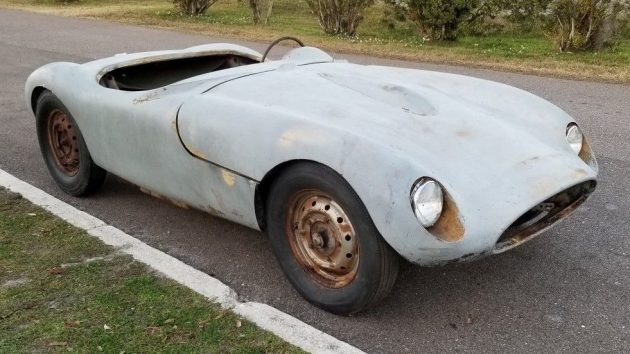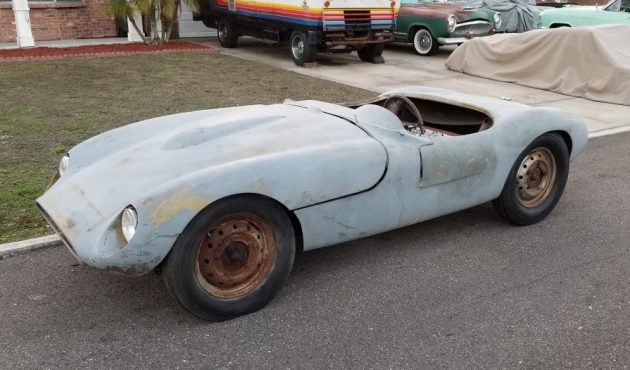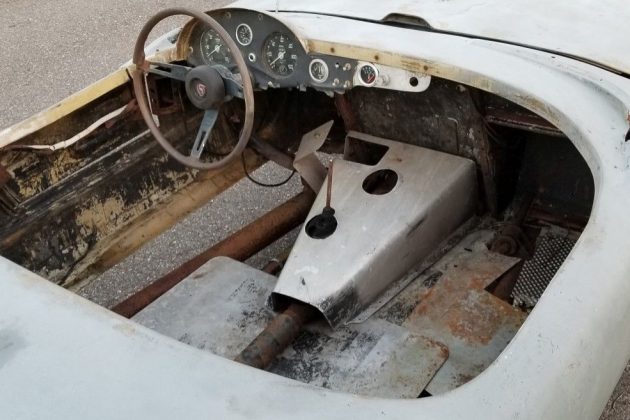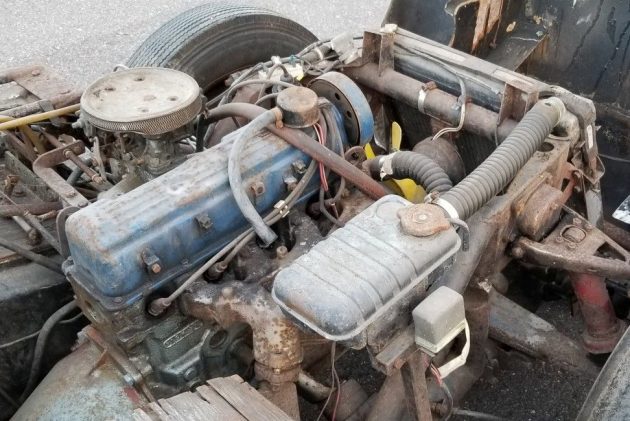Even if you don’t know anything about the early cars from Devin Enterprises, like the example found here on eBay, you certainly know the famous family of similar styles born in the 1950’s. The Ferrari 500 Mondial, with its signature aggressively sloped grill. The Bristol AC and its American spawn, the Shelby Cobra MKII. The Siata 208S, and the legendary Aston Martin DB2 Spider.
All these cousins featured a prolonged hood sitting between bulbous front fenders. Most had utilitarian cockpits that laughed in the face of safety and comfort. In the rear were shortened trunks on higher, muscular haunches. The Devin available here fits that description well, with one picture from the seller harkening back to it’s earlier days – and still wearing it’s bare fiberglass patina.
Underneath the Devin exterior is a 1953 Jowett Jupiter – a handsome car in its own right, with a racing pedigree that includes a class record breaking win in its rookie year at the 1950 LeMans. I personally like the Devin a bit more than the donor original body, and a quick look at recent prices confirms that a number 1, beautiful example of a Jowett still comes in less than a similar Devin survivor.
More than anything, I think the lineage of Devin offerings are uniquely American. Made to rival the Ferrari’s of the day – at a fraction of the cost and twice the fun. Sure, we all want to arrive at a show in a 375, or have the valet park the 250 right up front. I’ll take myself out of that clan, however, and dream of pulling up in a 1957 Devin D. It’s a bit smaller, obviously inspired by the 550, and is a classic ode to our U.S. tradition of making the unattainable, attainable.






A Jowett Jupiter Special is always going to be of interest – the typical “Italian” Devin body of this car will naturally appeal to many.
One should never forget or dismiss the first Devins with their French based design (Deutsch-Bonnet circa 1953) and their Panhard components allied to Devin’s own chassis:
http://www.devinspecial.com/devin-panhard.html
Not every Jowett Jupiter is inexpensive. The 1952 Le Mans class winning ex-works car (the only one surviving) is offered at £245,000 ($343,000). The works competition bodies certainly left no doubt about being a serious race cars:
https://www.carandclassic.co.uk/car/C915436
Steering wheel appears to be from an old Mazda…
How about a 240z on that steering wheel?
That adds to reserve price 😜👀
I love the body styling,really sexy,with a hint
of fire breathing power.I would love to resto-mod this,
but would be afraid of ruining its collectable value.
Can you imagine how much fun this would be with a
small v8,modern drive train..some comfy seats,?
This sure would get attention at any gathering…really cool.
Love the Resto-Mod concept as well!
Am I the only guy wondering what is under the cover in the background?
Engine looks like a ford 2300. Any Jowett Jupiter might be the frame.
It looks like a 2000…. Or 2 litre same as my 73 Pinto had.,
Great engine,but not what I’d want in that sweet body..,
I’d love to have it though….super cool..😎
Shame the original motor is gone and some OHC Ford product is in its place. Shame they destroyed a beautiful Jupiter, but at the time they were probably plentiful in comparison to today. The original Jowett motor was the basis for the Subaru motor. The Subaru company purchased the blueprints after the war.
MADBRIT,
Ha…finally..I had assumed that the Subaru…had “copied” the Lancia Flavia engine…same configuration, but the Flavia was FWD…so the Suba..was designed after the Jowett….GOOD TO KNOW.
What is your source for the blueprint reference?
Hi All,
This is a drawing of the Jupiter chassis.
I wonder how much of the original has been cut away for the in line engine.
One of the important things about the Jupiter was it’s low centre of gravity with the boxer engine and the very strong support of the upper control arm. Also has thee rack and pinion box been lost.
I own and have competed in Jupiter E1SA431R Chassis number.
This is our fiberglass Fairthorpe Electron Minor next to our Jowett Jupiter.
The farirthorpe uses Triumph components and a 1300 engine. It is very quick.
Doug,
The pictured Fairthorpe caught my eye, as I have a similar car. These seem to have a different nose than the one referenced by James HGF that is for sale in Germany, which has a more oval grille (vs. flattened pear-shaped), and has more elaborate sculpturing around the headlights. I take it you are from Australia? I’m in the USA, and, other than in pictures, my Fairthorpe is the only one I’ve ever seen. From the internet, I’ve concluded that there were several slightly-different noses made over the years.
Very interesting, would go well with the Jowett engine (which shouldn´t be too hard to source).
@ madbrit. Never heard that before. Subaru only started with flat 4 in 1966, and Jowett were long out of business by then. Who would they buy the rights from and why? Subaru is part of Fuji, massive company which wouldn´t need to copy a 1940s design which helped bankrupt Jowett with warranty claims.
All the Jowett cars were boxer engines from the early 1900’s till the finish in 1954.
Ford had a lot to do with their demise by buying the Brigs Motor Body Works and enforcing the terms of the contract. They were in trouble by then though.
I also own Jowett Javelin and Bradford.
https://www.facebook.com/groups/jowett.australia/
I’m also a bit dubious with the Subaru/Jowett connection.
Martin’s 100% correct with the warranty claims. The first generation Javelin/Jupiter engines had a very weak crank. I owned S/N E1SAL266 back in the late 1970s and it had a late (SC) Jupiter engine installed for the reason I just mentioned.
What finally killed off the Jowett company was that its body panel supplier was unable to supply components.
The Jupiter was a neat car to drive, and I’m with MadBrit that a Jowett engine would look more at home in the engine bay than the Pinto SOHC Four. A Devin-Jupiter would make a fun classic racer.
That was the story from way back when I lived in the UK for my first 45 plus years. Someone owned those design plans and as I said in another post, the Japanese bought a lot of older designs and revamped them. Other examples were that they could not perfect tires so they bought Dunlop. They (think it was Kawasaki) even produced a copy of a BSA motorcycle and compared it to the British version saying they took the original and made it better.
I´m also British, well used to hearing this “won the war, lost the peace” excuse for losing markets by selling bad product into captive (mainly colonial) markets.
It is true that the first post war Datsuns were Austin A40 Somersets built under license, just as the Hillman Minx was licensed to Isuzu. I don´t know much about bikes, but the Japanese product was reliable in a way that the UK product never has been and started with small bikes rather than big ones.
The Subaru copy story is hearsay which is not credible. As mentioned earlier, Jowett was long-gone before Subaru started producing their engine and the game had moved on a lot in that time.
In the case of Dunlop, for example, the takeover wasn´t until 1985 by which time the Japanese had mastered the art of making tyres (Bridgestone?), and Dunlop was a brand in trouble. Part of the globalisation of everything which also affected Goodyear and Firestone.
True that Briggs was bought by Ford, but was that partly because of cashfow problems caused by Jowetts failure to sell Javelins in the expected quanitities? I remember seeing mid 50s photos of Javelin bodyshells stockpiled in the snow outside the Yorkshire factory.
Sweet Kaisers in the background!
Many of the small ‘specials’ in the US, and even the British AC Bristol bodies from the UK, were inspired by the Ferrari Barchettas of the late ’40s and ’50s. They became the model for a small open sportscar, and many of the Devin bodies were inspired by them.
Anyone interested in these cars would find the website http://www.forgottenfiberglass.com interesting. It’s the first stop to make when you want to find out about old ‘glas cars, especially those from the USA.
When I first glanced at this Jowett Jupiter Speical listing and eBay advert this morning I expected someone to mention Geoff Hacker and Forgotten Fiberglass not specifically about Devin info, but as the possible seller as it appears to be parked in front of his house. What lurks beneath the tarps?
As wikipedia states the first “$295” Devin body was taken from a mold of the Ermini 375 (actually the model number is 357 as I found in La Sport E I Suoi Artigini 1937 – 1965 published by Giorgio NADA Editore) Sport 1100 (DOHC 1094cc) with body by Scaglietti. Scaglietti of course bodied many competition Ferraris.
Another link to a fiberglass bodied Jowett Jupiter for sale this time with a Rochdale roadster body and a price of £42,000. Lots of photos (contemporary and current) of JST53 allow one to view the standard Jupiter chassis, engine and layout:
http://www.cotswoldcars.com/currentstock/jowett-rochdale-jupiter
I agree with Martin Horrocks on sourcing a Jowett engine however, the Devin body would require a nose lump to cover the Jowett water pump unless the engine could be located where the current Pinto (?) engine is. Do hope it’s returned to a late ’50s or very early ’60s configuration rather than mucking it up with excess weight and power, but I’m not bidding.
That Rochdale Jowett has been for sale a long time, way too expensive and the history claimed for it is rather exaggerated in importance (similar to the Falcon which recently made big money on BaT) ie interesting and nicely done car, but basically the sum of its parts rather than added value historically important race car.
Ref later suggestion of fitting the Alfa 1300, I have a rolling Ginetta G4 chassis, and keep thinking that it makes more sense to spend $2000 on a 1300 Alfa and box than $10000 on a built Ford Kent. Car would be perfect….but the purists would hate it
As stated, the first Devin ‘295’ body was taken from a 357 Ermini (with aluminum body by Scaglietti) of which only three were built. The fiberglass Devin body evolved over time with continual changes. The final iterations were the Devin SS, Devin D, and Devin C, which were complete cars with Devin designed frames and bonded bodies.
A day…er 4 days late…and always a dollor (or a euro/pound) short. But it is nice not to be tethered to a fibre optic cable at all times. Was astonished by the claims made for the Falcon on BaT. Jeez Louise – over the top.
Have always admired the G4 from the first article I read a long, long time ago. Thought it would be perfect for me…the kid. But the standard Brit sports cars were the reasonable choices for the miles chalked up in a harsh environment. Like originals myself, but if the 1300 Alfa and box can be inserted w/o hassle saving $8,000 now and leaving open the option to return to factory spec later it seems a good choice.
Looks like something Geoff Hacker would find… since he’s the seller. Definitely would prefer Jowett power although as a special with Italianate lines, an Alfa or Lancia engine would fit the bill. Neat as a period build but I’d rather have an intact Jupiter (even a project). Very unusual cars.
My meandering reply to Dolphin took so long in writing I find much to my delight that Doug Rath has commented with serious info, photo, and chassis drawing. Thanks Doug. Glad you included the Fairthorpe Electron Minor. As I expect you know there is a street version available in Germany for €17,000. LInk:
http://www.oldtimerservice-kranz.de/oldtimer/1960-fairthorpe-electron-minor-mk2/
And Bullethead confirms Hacker as seller. 1300cc Alfa seems a good fit.
As an owner of two Devins–one a Devin Panhard and the other the “295” Monza-like body. I’ve been researching these cars for a number of years.
It is my opinion that this body is not a Devin based any number of differences from my unmolested 1956.
After WW2 the Japanese bought a lot of old designs to help catch themselves back up. It was not uncommon for Japanese car companies to buy older designs and revamp them. For example, the Datsun 4 and 6 cylinder motors were a direct descendant of the Austin/Morris engines. In fact some parts of the 4 cylinder ones interchange, not sure about the 6 cylinders.
Would a 260 CI Ford engine be too wide for the engine bay?
And what would you have then? An expensive poor-man’s Ford powered Devin SS “replica” with a Devin-copy body and a badly twisted chassis!
Madbrit is correct about THE Subaru connection … also many engines where built under license agreements …some parts where interchangeable but this was things like manifolds … British engines used imperal measurnents in odd sizes like AF & Whitworth … the
Japanese zaibatsu (business conglomerates) began building their first automobiles in the middle to late 1910s. The companies went about this by either designing their own trucks (the market for passenger vehicles in Japan at the time was small), or partnering with a European brand to produce and sell their cars in Japan under license. Such examples of this are Isuzu partnering with Wolseley Motors (UK), Nissan partnering with British automaker Austin, and the Mitsubishi Model A, which was based upon the Fiat Tipo 3. The demand for domestic trucks was greatly increased by the Japanese military buildup before World War II, ..metric was adopted later
https://en.wikipedia.org/wiki/Jowett_Cars
@ Scott Tait. Basically what you say is correct and referred to above ie Datsun/Austin and Isuzu/Rootes (Wolseley, don´t know, BMC sub-brand post-war so doubt it). Renault/Hino is another example. Later the collaboration went the other way, Triumph and Rover selling (more or less) badge-engineered Hondas.
What I doubt is any connection between Subaru and the Jowett flat four, have never seen any reference to this in print or heard it in conversation. Is there any evidence for this other than anecdote? If there is, would be interesting to know, but feels improbable. Why copy one of the very few boxer engines with well-known reliability issues?
Subarau didn’t copy the actual design, they took the general design and perfected it. One assumed they wanted a flat four design and the Jowett one was the only one available to either purchase cheaply or simply to take as the company was no longer in existence.
Found this interesting snippet which may shed some light on the later engine no longer having unreliability problems:
Jowetts before the Second World War were best known for their flat twin engines, but they made a flat-four for the Jason and 10 hp models in the 1930s. Post-war Gerald Palmer designed Javelin saloon and Jupiter sports models used a totally different design of flat-four.
It’s not a Devin body, it’s a Byers body
You’re absolutely right, that is NOT a Devin body. There are some similarities to a Devin body but every surface is different, the clamshell hood, the (single) door, the grille.
For a brief history of Jowetts http://jowett.net/#templatemo_timeline
If you want to discuss or learn more why not try the Jowett forum https://jowett.net/forum/viewforum.php?f=1
Registering will also open up some of the archive on Jowetts.
There´s no Jowett/Subaru story, then. Benz patented flat layout in 1895 (2 cylinder) and both Tatra and VW had flat 4 cylinders in the 1930s. You´d have to say that VW and Porschein particular had perfected the concept long before Subaru came on the scene in 1966.
Maybe Jowett´s contribution to history was to design an unreliable boxer engine, seemingly hard to do. Pretty much all the boxers I can think of have been excellent (VW, Porsche, Tatra, Alfa, Subaru, Citroen, Lancia and so on). The only reason to buy a Jowett pre WW2 was their outstanding reputation for reliability, which the Javelin soon ruined, great concept though it was.
Martin, you obviously have your thoughts about this and others have theirs. It does appear that there were 2 designs for the Jowett flat four and the second one was better than the first. I will stick to my story that was told to me years ago by an avid Jowett fan and owner. We will probably never know the truth.
Didn’t Fairthorpe make bodies for the Ford Anglia E93A platform too. There were a bunch of these body makers back then. A guy down the street had one, looked beautiful until someone sat in it and then it showed just how small it really was…… LOL.
Fairthorpe used the Microplas’ Mistral fiberglass body for the first Electrons before they began manufacturing their own bodies. Perhaps the car you saw wore a Mistral body. Not aware of Fairthorpe selling any outside their complete kits. They built bodies for themselves not others. As you state there were “a bunch of these body makers back then”. Some designs were rather similar for myriad reasons.